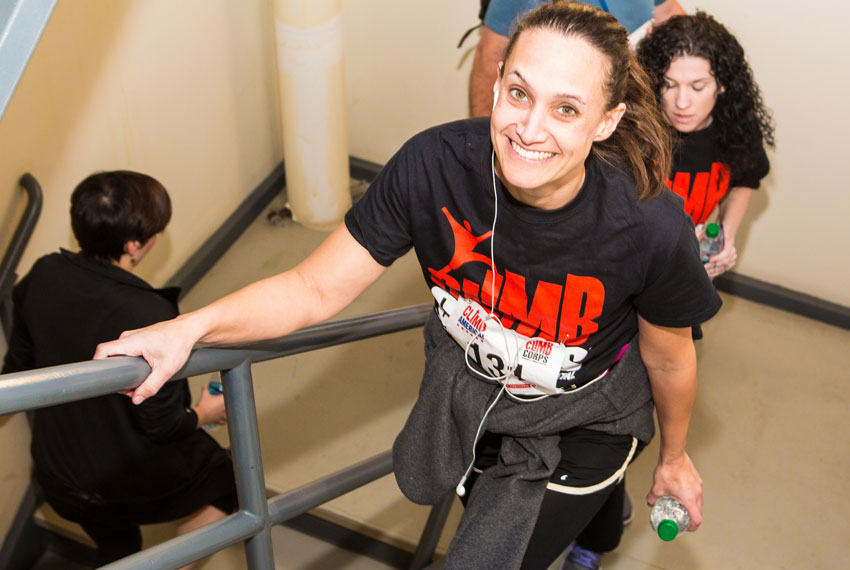Turning a Staircase into a Gym

ClimbAmerica image provided
Taking the stairs is a great way to see how in shape you really are. A few flights in, your legs are burning, your breathing is heavy, and your heart starts to hammer loudly in your ears. But that’s ClimbCorps’ favorite part about climbing the stairs; the way it makes you aware of your heart.
In 2012, the Cardiovascular Wellness Center at Brigham and Women’s Hospital founded ClimbCorps, a non-profit interested in spreading awareness about heart disease. But the director of the center, Dr. JoAnne Foody, didn’t want just another annual walk-a-thon for research; she wanted an active campaign to educate the city about the importance of exercise in combating heart disease.
“It’s October so we’re hearing a lot about cancer,” Foody, who also serves as the medical director of ClimbCorps, says. “But what people don’t understand is that heart disease is the number one killer disease in America. Ten times more women die from heart disease than from breast cancer. But, unlike cancer, we can prevent it.”
Dr. Foody saw that people needed to be educated about exercise and its relation to heart health. Maintaining a healthly lifestyle by exercising is the key to preventing heart disease, but no one has time to go to the gym all the time, especially with long work weeks. So Foody thought she’d bring the exercise to them.
“We all essentially have built-in health clubs in every building,” Foody says. “You don’t need to pay more for the stairs, you don’t need any other resources. It’s almost too simple, but its remarkable how few people use the stairs.”
Using the stairs allows Boston’s office workers—in the 16 buildings that ClimbCorps operates, there are more than 200,000 people—to exercise during their work day.
ClimbCorps consists of two parts: ClimbClub which is a group of trained ClimbCorps associates who lead organized stair climbs around Boston, and ClimbAmerica which hosts biannual public climb events—akin to a walk for hunger or breast cancer—to raise funds and awareness.
ClimbAmerica’s biannual events help to raise awareness and funds in a familiar way. Once in January and once in June, Boston residents can gather together for free in the lobby of one of the city’s tallest buildings and climb together to the top.
“It’s a vertical walk-a-thon,” says Peter Siclari, a ClimbCorps trained associate. “People come out to show support for the cause and to show support for the people affected by heart disease.”
In the tradition of a walk for breast cancer or for hunger, ClimbCorps puts the money raised from these climbing events toward health workshops and community outreach programs to spread awareness.
Foody says that these community outreach programs are going to begin to spread to local high schools starting in 2014, in an effort to start educating people at a younger age about what they can do for themselves with their health.
The other part of the non-profit, ClimbClub, is slowly infiltrating office buildings across the city. ClimbClub combines the heart-pumping health benefits of a gym workout with the educational aspects of national disease prevention campaigns. Its main goal, says Siclari, is to let people know that their health is largely in their hands.
“We’re not preaching to people,” Siclari says. “We just want to remind people that there are, in fact, a lot of controllable factors in their health.”
Participants gather together in large groups with a trained ClimbClub associate or in small pairs with fellow colleagues, and climb the stairs.
“It’s better than any workout I’ve ever done,” says Eileen Codyer. Codyer is a project analyst at Ropes and Gray in the Prudential Center who, twice a week, climbs all 52 flights of stairs in the building.
“I’ve been a member at various gyms all my life but this is nothing like walking on a stairmaster where you’re just climbing and not going anywhere,” Codyer says. “I like having that end goal at the top of the 52nd flight as a motivator.”
In the Prudential Center, one of 16 Boston buildings where ClimbCorps hosts stair events, there is a painted face of what looks like Alfred Hitchcock on the wall at the top of the stairs.
“We all have a sort of slogan now,” Codyer says. “You have to get to the face! You know you’re done when you can slap that face on the 52nd floor!”
Whether you make it to the top in half an hour or two hours, it doesn’t matter to ClimbCorps. Any progress up the stairs means a healthier heart. This no-pressure approach to fitness is what attracted Codyer to the program.
“Some people only go up and down ten flights of stairs, because that’s all they want to do,” she says. “And they don’t feel any pressure from me as I go up and down all 52, and I don’t feel any pressure from the people who run up and down all 52 flights. It’s like you’re competing with yourself, and not with anybody else.”
Foody and the Cardiovascular Wellness Center are also studying the participants of ClimbClub to test the effectiveness of such a simple program. She says some climbers even get to a point where they can stop taking their diabetes or blood pressure medicine.
“I started climbing in April, and when I went to a doctor’s appointment a few months later,” Codyer says, “my usually high blood pressure was down under the normal level. It was amazing to see the results in such a short amount of time.”
In addition to the physical health benefits, Siclari says that people like the opportunity to take a mental break as well.
“I think people like it because it breaks up their day,” Siclari says. “Most people are sitting at desks all day and they want to get up and move around so they come to us.”
Because of its popularity, Foody is looking ahead to a future full of office ClimbClubs.
“Our vision for ClimbClub, really,” says Foody, “is to turn the stairwell in every office building into a fitness venue. We want to empower everyone to take those literal steps forward toward improving their health.”


